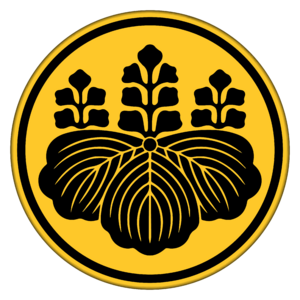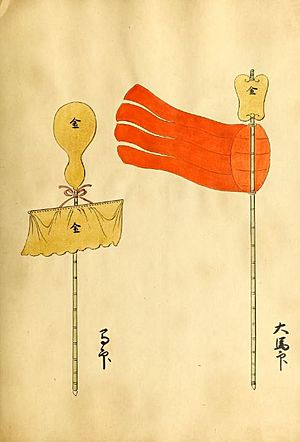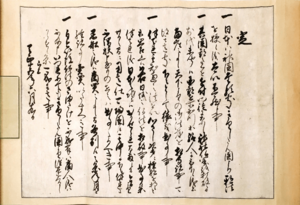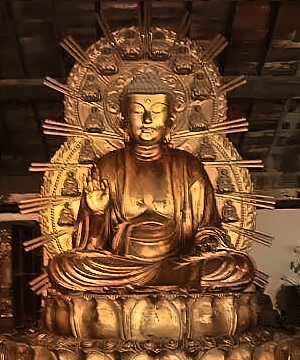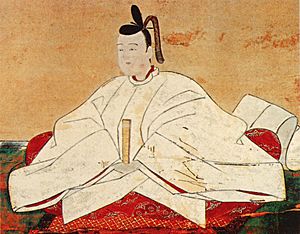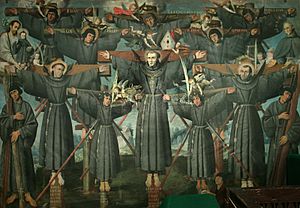Toyotomi Hideyoshi facts for kids
Quick facts for kids
Toyotomi Hideyoshi
|
|
|---|---|
| 豊臣 秀吉 | |
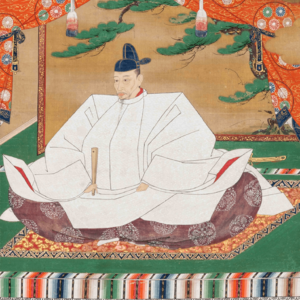 |
|
| Chief Advisor to the Emperor (Kampaku) |
|
| In office August 6, 1585 – February 10, 1592 |
|
| Monarch | |
| Preceded by | Nijō Akizane |
| Succeeded by | Toyotomi Hidetsugu |
| Chancellor of the Realm (Daijō Daijin) |
|
| In office February 2, 1586 – September 18, 1598 |
|
| Monarch | Go-Yōzei |
| Preceded by | Konoe Sakihisa |
| Succeeded by | Tokugawa Ieyasu |
| Head of Toyotomi clan | |
| In office 1584–1598 |
|
| Succeeded by | Toyotomi Hideyori |
| Personal details | |
| Born |
Hiyoshi-maru (日吉丸)
February 2, 1537 Nakamura, Owari, Japan |
| Died | September 18, 1598 (aged 61) Fushimi Castle, Kyoto, Japan |
| Spouses |
|
| Domestic partner | Kaihime (concubine) |
| Children |
|
| Parents |
|
| Relatives |
|
| Religion | Shinto |
| Other names |
|
| Divine name | Toyokuni Daimyōjin (豊国大明神) |
| Posthumous dharma name |
Kokutai-yūshō-in-den Reizan Shunryū Daikoji (国泰祐松院殿霊山俊龍大居士) |
| Signature |  |
| Nickname | "Saru" (monkey) |
| Military service | |
| Allegiance |
|
| Rank | Daimyō, Kampaku, Daijō-daijin |
| Unit | |
| Commands | Osaka Castle |
| Battles/wars | Siege of Inabayama Siege of Kanegasaki Battle of Anegawa Siege of Nagashima Battle of Ichijodani Siege of Itami Battle of Nagashino Siege of Mitsuji Battle of Tedorigawa Siege of Miki Siege of Tottori Siege of Takamatsu Battle of Yamazaki Battle of Shizugatake Battle of Komaki and Nagakute Negoro-ji Campaign Toyama Campaign Kyūshū campaign Odawara Campaign Korean Campaign see below |
| Toyotomi Hideyoshi | |||||
|---|---|---|---|---|---|
| Japanese name | |||||
| Kana | とよとみ ひでよし or とよとみ の ひでよし | ||||
| Kyūjitai | 豐臣 秀吉 | ||||
| Shinjitai | 豊臣 秀吉 | ||||
|
|||||
Toyotomi Hideyoshi (error: {{nihongo}}: Japanese or romaji text required (help)) was a famous Japanese samurai and powerful lord, known as a daimyō. He is remembered as the second "Great Unifier" of Japan.
Hideyoshi started from a very humble background. He was a simple peasant who became a loyal helper to the important lord Oda Nobunaga. Over time, Hideyoshi grew to be one of the most powerful people in Japan. After Nobunaga's death in 1582, Hideyoshi took over his mission to unite Japan. This helped end the long period of wars known as the Sengoku period.
By the mid-1580s, Hideyoshi became the real leader of Japan. He gained important titles like Chancellor of the Realm and Imperial Regent. In 1592, he launched invasions of Korea. These started well but eventually led to a military stalemate. Hideyoshi died in 1598. His young son, Toyotomi Hideyori, was later replaced by Tokugawa Ieyasu. This led to the start of the Tokugawa shogunate.
Hideyoshi's time as ruler is part of the Azuchi–Momoyama period in Japan. This period is partly named after his castle, Momoyama Castle. Hideyoshi left a big mark on Japan. He built Osaka Castle and helped create the Tokugawa class system. He also made rules that only samurai could own weapons. Many temples he built or fixed can still be seen in Kyoto today.
Contents
Early Life and Humble Beginnings
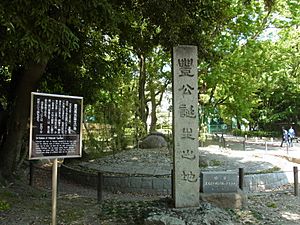
Not much is known about Toyotomi Hideyoshi's early life before 1570. He didn't write much about his past in his own story.
It is believed that Hideyoshi was born in the early 1500s in Nakamura, Owari Province. This was during the very chaotic Sengoku period, when Japan had no strong central government. Hideyoshi did not come from a samurai family. His father, Kinoshita Yaemon, was an ashigaru, which means a peasant foot soldier. Hideyoshi didn't have a family name at birth. His childhood name was Hiyoshi-maru, meaning "Bounty of the Sun." His father died when Hideyoshi was only seven years old.
Many stories say that Hideyoshi was sent to study at a temple when he was young. But he didn't like temple life and went looking for adventure instead. He used the name Kinoshita Tōkichirō. He first worked for the Imagawa clan as a servant. He even traveled to the lands of Imagawa Yoshimoto, a powerful lord. But he later left, taking some money that had been given to him.
Serving Under Oda Nobunaga
In 1558, Hideyoshi became a foot soldier for the strong Oda clan. This clan ruled his home province of Owari. The clan was then led by the ambitious Oda Nobunaga.
Hideyoshi quickly became Nobunaga's sandal-bearer. This was a respected job. People say he also helped fix Kiyosu Castle and managed the kitchen. Nobunaga noticed Hideyoshi's talents. After Nobunaga won the Battle of Okehazama in 1560, Hideyoshi became one of his trusted helpers.
In 1561, Hideyoshi married One. She was the adopted daughter of Asano Nagakatsu. Hideyoshi also helped repair Sunomata Castle. He worked with his younger half-brother, Hashiba Koichirō. His efforts were praised because Sunomata was in enemy territory. Legend says Hideyoshi built a fort there overnight. He also found a secret path into Mount Inaba. This led many local soldiers to surrender.
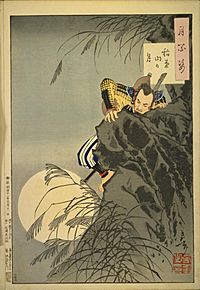
In 1564, Hideyoshi was a very good negotiator. He convinced many lords from Mino to leave the Saitō clan. He used gifts and talks to get them to join Nobunaga. This included the Saitō clan's main planner, Takenaka Shigeharu.
Nobunaga's easy win at the siege of Inabayama Castle in 1567 was largely thanks to Hideyoshi. Even though he was from a peasant family, Hideyoshi became one of Nobunaga's best generals by 1568. He later took the name Hashiba Hideyoshi. This new name included parts from Nobunaga's other important men.
In 1570, Hideyoshi protected Nobunaga's retreat from enemy forces at Kanegasaki. His defense of his lord's escape became a famous story. Later, at the Battle of Anegawa, Hideyoshi led Oda troops in open battle for the first time.
In 1573, after winning against the Azai and Asakura clans, Nobunaga made Hideyoshi a daimyō (a powerful lord) of three districts. Hideyoshi moved to a town he renamed "Nagahama" to honor Nobunaga. He also took control of a nearby factory that made firearms. Under Hideyoshi, the factory made many more weapons.
Nobunaga's Death and Hideyoshi's Rise
During the Siege of Takamatsu in 1582, Oda Nobunaga and his son were killed. They were betrayed by Akechi Mitsuhide at the Honnō-ji incident in Kyoto. This stopped Nobunaga's plan to unite Japan.
Hideyoshi wanted revenge for his lord's death. He quickly made peace with the Mōri clan. Just thirteen days later, he met Mitsuhide and defeated him at the Battle of Yamazaki. This avenged Nobunaga and allowed Hideyoshi to take over Nobunaga's power.
Building Osaka Castle

In 1582, Hideyoshi started building Osaka Castle. It was built where a temple once stood, which Nobunaga had destroyed. The castle was finished in 1597. After Hideyoshi's death, it became the last stronghold of the Toyotomi clan.
Becoming the Top Leader

By 1583, Hideyoshi was very strong. He gathered powerful lords to decide who would take over from Nobunaga. Hideyoshi chose Nobunaga's young grandson, Samboshi. He gained the support of other important Oda clan leaders. This helped him secure Samboshi's position and increase his own power within the Oda clan.
Soon, there was tension between Hideyoshi and Shibata Katsuie. At the Battle of Shizugatake the next year, Hideyoshi defeated Katsuie's forces. This victory helped Hideyoshi become even more powerful. He now controlled many provinces.
In 1584, Nobunaga's other son, Oda Nobukatsu, was still against Hideyoshi. Nobukatsu joined forces with Tokugawa Ieyasu. They fought at the Battle of Komaki and Nagakute. The battle ended without a clear winner, but Hideyoshi's forces suffered losses. Hideyoshi and Ieyasu never directly fought each other. Eventually, Hideyoshi made peace with Nobukatsu. To show his commitment, Hideyoshi sent his younger sister and mother to Ieyasu as a sign of trust.
Hideyoshi never became a shōgun (the military ruler of Japan). Instead, he was adopted by a noble family, the Fujiwara clan. This allowed him to gain high court titles. In 1585, he became the Imperial Regent (kampaku). Also in 1585, the Emperor gave him the new family name Toyotomi. He built a grand palace, the Jurakudai, in 1587. The next year, he hosted the Emperor there.
Uniting Japan
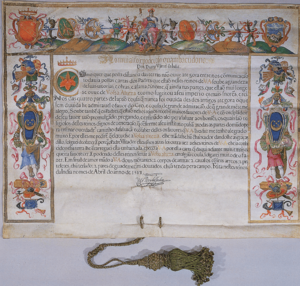
Hideyoshi continued his efforts to unite Japan. He led several military campaigns.
Campaigns Across Japan
In 1585, Hideyoshi attacked and took control of Kii Province. He defeated the warrior monks of Negoro-ji, who were skilled with firearms. These monks had supported his rival, Tokugawa Ieyasu. Hideyoshi's forces burned down their monastery.
Next, in 1585, Toyotomi forces invaded Shikoku island. Hideyoshi's army was huge, with over 100,000 soldiers. They faced the Chōsokabe clan, who had about 40,000 men. Despite the odds, the Chōsokabe leader chose to fight. The battles ended with the siege of Ichinomiya Castle. Chōsokabe surrendered and was allowed to keep one province. The rest of Shikoku was given to Hideyoshi's generals.
In late 1585, Hideyoshi attacked Etchū Province and Hida Province. He sent his general Kanamori Nagachika to defeat the Anegakōji clan. Hideyoshi himself led an army of about 100,000 soldiers against the Sassa Narimasa forces. Narimasa's defense was broken, giving Toyotomi control over these provinces.
In 1586, Toyotomi Hideyoshi conquered Kyūshū. He took control from the powerful Shimazu clan. Hideyoshi's half-brother, Toyotomi Hidenaga, landed on the eastern coast. Hideyoshi led his own forces on a western route. The two brothers met up in the Shimazu home province. They besieged Kagoshima castle, the Shimazu clan's main base. The Shimazu surrendered.
Later in 1587, Hideyoshi banned Christian missionaries from Kyūshū. He wanted more control over the Christian lords. However, he still traded a lot with Europeans, so he often overlooked individual Christians.
The Great Sword Hunt
In 1588, Hideyoshi made a big change. He ordered that ordinary peasants could no longer own weapons. He started a "sword hunt" to collect all weapons. The swords were melted down to make a statue of the Buddha. This rule helped stop peasant revolts. It also brought more stability to Japan.
The Last Resistance
In 1590, Hideyoshi led the Odawara Campaign against the Later Hōjō clan. This was the first time Hideyoshi and Tokugawa Ieyasu worked together. Hideyoshi's huge army of 220,000 men surrounded Odawara Castle. The Hōjō had 82,000 defenders. The siege was unusual; samurai were entertained with music and acrobats. The defenders held strong. After three months, the Hōjō surrendered.
This victory removed the last major resistance to Hideyoshi's rule. It marked the end of the Sengoku period. During the siege, Hideyoshi offered Ieyasu eight provinces in exchange for his five provinces. Ieyasu accepted.
The Kunohe Rebellion
The Kunohe rebellion was a revolt in 1591. It happened in Mutsu Province. Kunohe Masazane rebelled against his rival, Nanbu Nobunao. Nobunao was supported by Toyotomi Hideyoshi. Hideyoshi sent a large army to the Tōhoku region. The army quickly defeated the rebels. Hideyoshi's army arrived at Kunohe Castle in September. Masazane surrendered, but he and the castle defenders were executed. The Kunohe rebellion was the last battle in Hideyoshi's campaigns. It completed the unification of Japan.
Korean Campaigns
In 1591, Hideyoshi's only son, Tsurumatsu, died. This raised questions about who would take over after Hideyoshi. His half-brother, Toyotomi Hidenaga, also died soon after. So, Hideyoshi named his nephew, Toyotomi Hidetsugu, as his heir. Hideyoshi then stepped down as kampaku to take the title of taikō (retired regent). Hidetsugu became the new kampaku.
Hideyoshi's health was getting worse. But he still wanted to achieve something great. He decided to follow Oda Nobunaga's dream of conquering China. He planned to do this by invading Ming dynasty China through Korea.
Hideyoshi had been talking with the Koreans since 1587. He asked for safe passage into China. Korea was an ally of Ming China. The Korean government refused his requests. They were worried that Japanese troops marching through Korea would lead to battles on Korean soil. In August 1591, Hideyoshi ordered preparations for an invasion of Korea.
First Invasion of Korea
In April 1592, Hideyoshi sent his army to the Korean peninsula. Japanese forces quickly took Seoul, the capital of Korea. In just four months, Hideyoshi's forces had taken much of Korea. The Korean king escaped and asked China for help.
In 1593, the Chinese Emperor sent an army to stop the Japanese. This army recaptured Pyongyang. The Japanese navy was also destroyed by Admiral Yi Sun-sin of Korea. This stopped Japan's plan to conquer China. The Japanese troops in Seoul could not get supplies.
Succession and Christian Martyrs
The birth of Hideyoshi's second son, Toyotomi Hideyori, in 1593 created a problem. To avoid issues with who would rule next, Hideyoshi sent his nephew and heir, Toyotomi Hidetsugu, away. He then ordered Hidetsugu to end his own life in 1595. Hidetsugu's family members were also killed in Kyoto.
In January 1597, Toyotomi Hideyoshi had twenty-six Christians arrested. This was meant as a warning to Japanese people who wanted to become Christian. These people are known as the Twenty-six Martyrs of Japan. They included missionaries and Japanese laymen, including young boys. On February 5, they were executed in Nagasaki by public crucifixion.
Second Invasion of Korea
After years of talks, Hideyoshi launched another invasion of Korea. But this time, the Japanese forces had less success. They were stuck in Gyeongsang Province. In June 1598, Japanese forces fought off Chinese attacks. But they could not advance further. All sides were tired of the war. Hideyoshi told his commander in Korea, "Don't let my soldiers become spirits in a foreign land."
Hideyoshi's Death
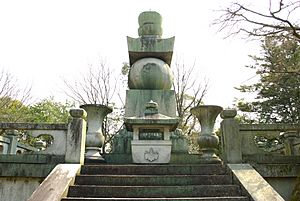
Toyotomi Hideyoshi died on September 18, 1598. His death was kept a secret by his top advisors. They wanted to keep up the morale of the soldiers. They ordered the Japanese forces in Korea to return to Japan. Because he failed to conquer Korea, Hideyoshi's forces could not invade China.
His military trips weakened his clan's money and fighting power. His helpers argued about who was to blame for the failure. The clans loyal to the Toyotomi clan became weaker. The Tokugawa government later stopped any more military trips to Asia. They also closed Japan to almost all foreigners for many years.
After Hideyoshi's death, his advisors could not control Tokugawa Ieyasu. Two of Hideyoshi's top generals joined Ieyasu. Hideyoshi's young son and chosen successor, Toyotomi Hideyori, lost the power his father once had. Tokugawa Ieyasu became shōgun after the Battle of Sekigahara in 1600.
Hideyoshi's Impact on Japan
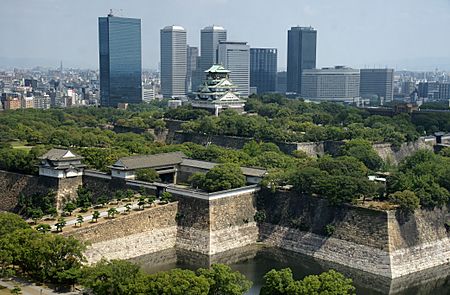
Toyotomi Hideyoshi changed Japanese society in many ways. He created a strict class system. He also limited travel and surveyed land and production.
His class changes affected common people and warriors. Before Hideyoshi, peasants could become warriors. Samurai might also farm. This was because of the constant wars. When Hideyoshi took control, he ordered all peasants to give up their weapons. He also made samurai live in castle towns. This made the social class system very strong for the next 300 years.
He also ordered full surveys and a complete count of everyone in Japan. Once this was done, he required all Japanese people to stay in their own areas. They needed official permission to travel elsewhere. This helped keep order when bandits were still common. The land surveys also helped create a system for taxes.
In 1590, Hideyoshi finished building Osaka Castle. It was the biggest and strongest castle in Japan. It protected the western approaches to Kyoto. In the same year, Hideyoshi banned "unfree labor" or slavery in Japan. However, other forms of forced labor still existed.
Hideyoshi also loved the Japanese tea ceremony. He spent a lot of time and money on it. He collected tea items and hosted grand events. He supported famous tea masters. As interest in the tea ceremony grew, so did the demand for beautiful ceramic items. During the Korean campaigns, many valuable ceramics were taken. Many Korean artists were also brought to Japan.
Inspired by the amazing Golden Pavilion in Kyoto, he built the Golden Tea Room. This room was covered with gold leaf. It was lined inside with red silk. He could take this mobile tea room with him. This allowed him to perform the tea ceremony wherever he went. It showed off his great power and status.
Politically, he set up a government system. It balanced the power of the strongest Japanese warlords (daimyō). A council was created with the most important lords. A regent was also chosen to be in charge.
Before he died, Hideyoshi wanted to create a stable system. He hoped it would last until his son was old enough to rule. He formed a Council of Five Elders (五大老, go-tairō). This council had the five most powerful daimyō. But after one of them died, Tokugawa Ieyasu started making alliances. He even arranged political marriages, which Hideyoshi had forbidden.
Eventually, the forces loyal to the Toyotomi clan fought against the Tokugawa clan. This was at the Battle of Sekigahara. Ieyasu won and became shōgun two years later.
Ieyasu kept most of Hideyoshi's rules. He built his government based on them. This meant Hideyoshi's cultural impact lasted. Hideyoshi once wrote to his wife:
I mean to do glorious deeds and I am ready for a long siege, with provisions and gold and silver in plenty, so as to return in triumph and leave a great name behind me. I desire you to understand this and to tell it to everybody.
Hideyoshi is remembered at several Toyokuni Shrines across Japan.
Names of Hideyoshi
Toyotomi Hideyoshi had many names during his life. This was because he started from a low birth. He eventually became the Imperial Regent, a very high noble title.
At birth, he was named Hiyoshi-Maru. When he became an adult, he took the name Kinoshita Tōkichirō. Later, he was given the family name Hashiba. He also received the court title Chikuzen no Kami. So, he was called Hashiba Chikuzen no Kami Hideyoshi. His family name stayed Hashiba even when the Emperor gave him the new clan name Toyotomi.
The Toyotomi clan name was also given to some of Hideyoshi's chosen allies. They adopted the new clan name "Toyotomi no ason," meaning "courtier of Toyotomi."
His full name in official papers was Hashiba Tōkichirō Toyotomi No Ason Hideyoshi.
Catholic writings from that time called him Cuambacondono (from kampaku and the title -dono). They also called him "emperor Taicosama" (from taikō, a retired kampaku, and the title -sama).
His lord, Oda Nobunaga, gave Toyotomi Hideyoshi the nickname Kozaru. This means "little monkey." It was because his face and thin body looked like a monkey's.
Honours
- Senior First Rank (August 18, 1915; given after his death)
See also
 In Spanish: Toyotomi Hideyoshi para niños
In Spanish: Toyotomi Hideyoshi para niños


